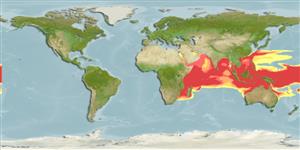Common names from other countries
>
Beloniformes (Needle fishes) >
Exocoetidae (Flyingfishes)
Etymology: Parexocoetus: Greek, para in the side of + Greek, exos = outside + Greek, koite = hole (Ref. 45335).
More on author: Valenciennes.
Environment: milieu / climate zone / depth range / distribution range
Écologie
marin; océanodrome (Ref. 51243); profondeur 0 - 20 m. Tropical; 30°N - 23°S, 20°E - 178°W
Indo-Pacific: widespread from East Africa, including the Red Sea and the Gulf, to southern Japan, Marshall Islands, Fiji, the Arafura Sea (Ref. 9819) and Queensland, Australia. Migrated to eastern Mediterranean through the Suez Canal (Ref. 6523). Presence in Somalia to be confirmed (Ref. 30573). Records from the Atlantic (as Parexocoetus mento atlanticus) are in error.
Taille / Poids / Âge
Maturity: Lm ? range ? - 13 cm
Max length : 11.0 cm SL mâle / non sexé; (Ref. 2797)
Épines dorsales (Total): 0; Rayons mous dorsaux (Total): 9-12; Épines anales 0; Rayons mous anaux: 10 - 12. Dorsal fin mostly blackish; pectorals and caudal greyish, other fins transparent (Ref. 2797).
Found in near-shore surface waters, never spread to open sea (Ref. 9839). Capable of leaping out of the water and gliding above the surface (Ref. 30573).
Most die after a single spawning (Ref. 205).
Parin, N.V., 1996. On the species composition of flying fishes (Exocoetidae) in the West-Central part of tropical Pacific. J. Ichthyol. 36(5):357-364. (Ref. 27313)
Statut dans la liste rouge de l'IUCN (Ref. 130435)
CITES (Ref. 128078)
Not Evaluated
Menace pour l'homme
Harmless
Utilisations par l'homme
Pêcheries: intérêt commercial mineur
Plus d'informations
RéférencesAquacultureProfil d'aquacultureSouchesGénétiqueElectrophoresesHéritabilitéPathologiesTraitementMass conversion
Outils
Articles particuliers
Télécharger en XML
Sources Internet
Estimates based on models
Preferred temperature (Ref.
115969): 25.9 - 29.1, mean 28.5 (based on 4012 cells).
Phylogenetic diversity index (Ref.
82804): PD
50 = 0.6250 [Uniqueness, from 0.5 = low to 2.0 = high].
Bayesian length-weight: a=0.00646 (0.00292 - 0.01429), b=3.04 (2.84 - 3.24), in cm Total Length, based on LWR estimates for this (Sub)family-body shape (Ref.
93245).
Niveau trophique (Ref.
69278): 3.3 ±0.4 se; based on size and trophs of closest relatives
Résilience (Ref.
120179): Haut, temps minimum de doublement de population inférieur à 15 mois (Preliminary K or Fecundity.).
Fishing Vulnerability (Ref.
59153): Low vulnerability (10 of 100).
